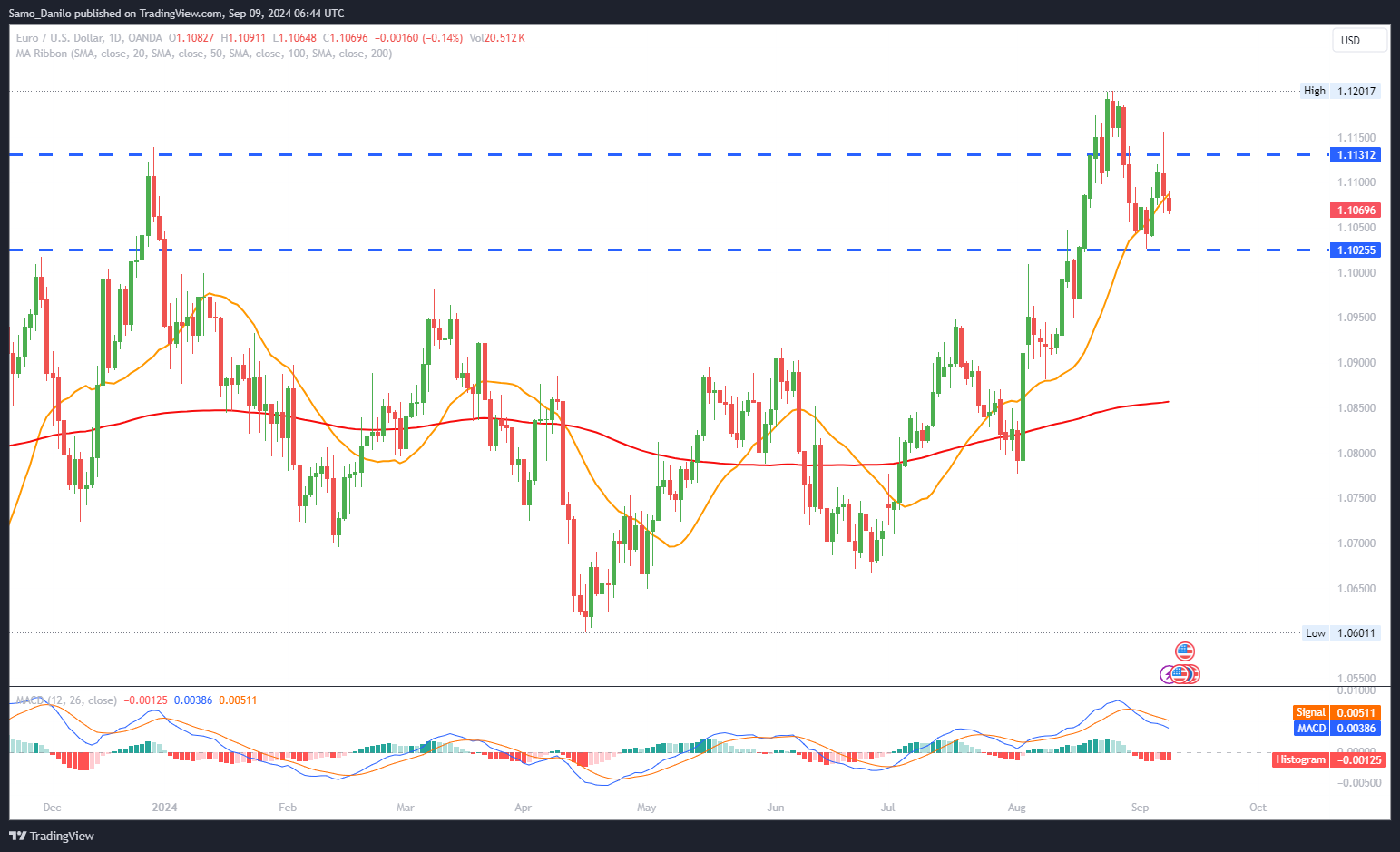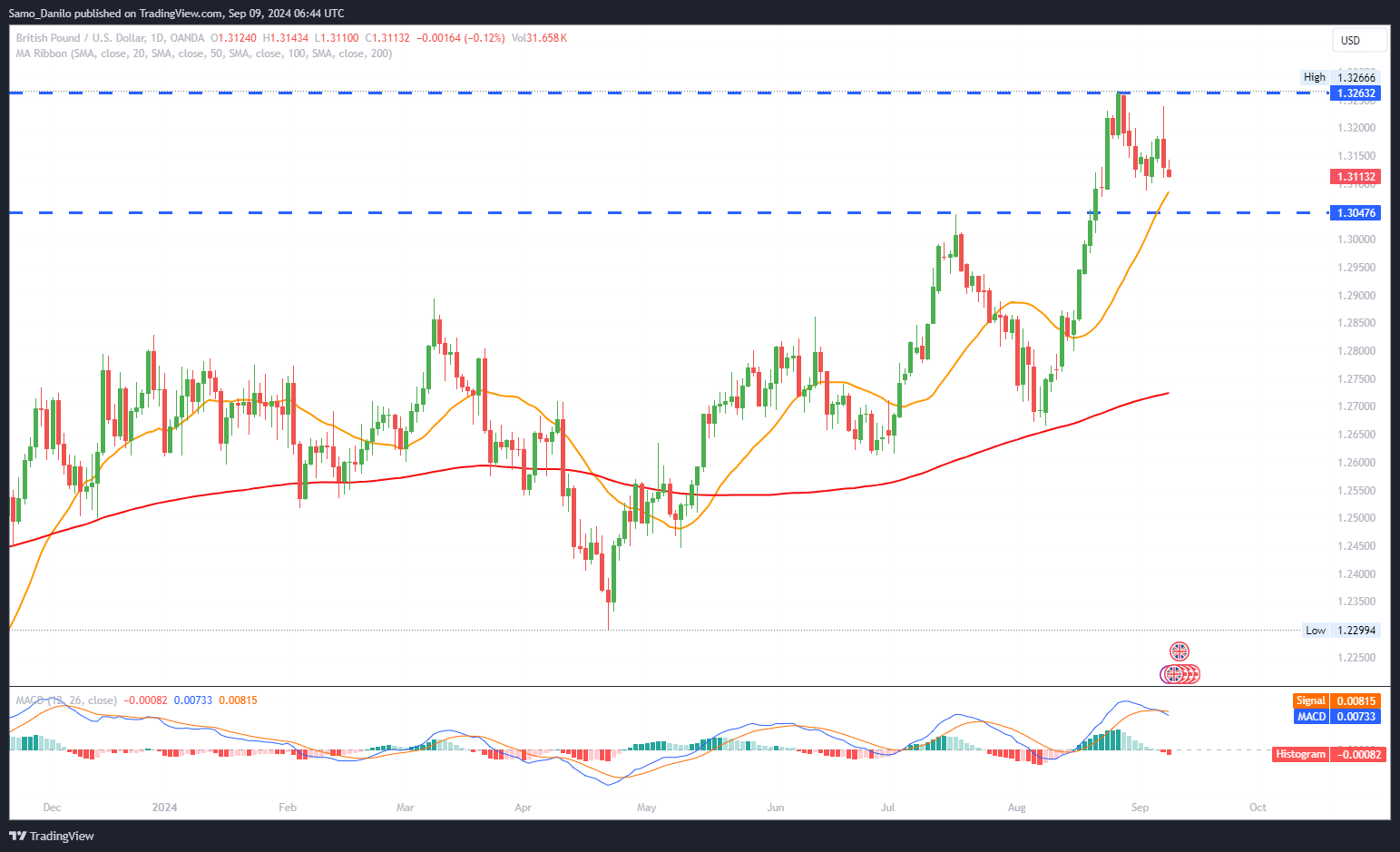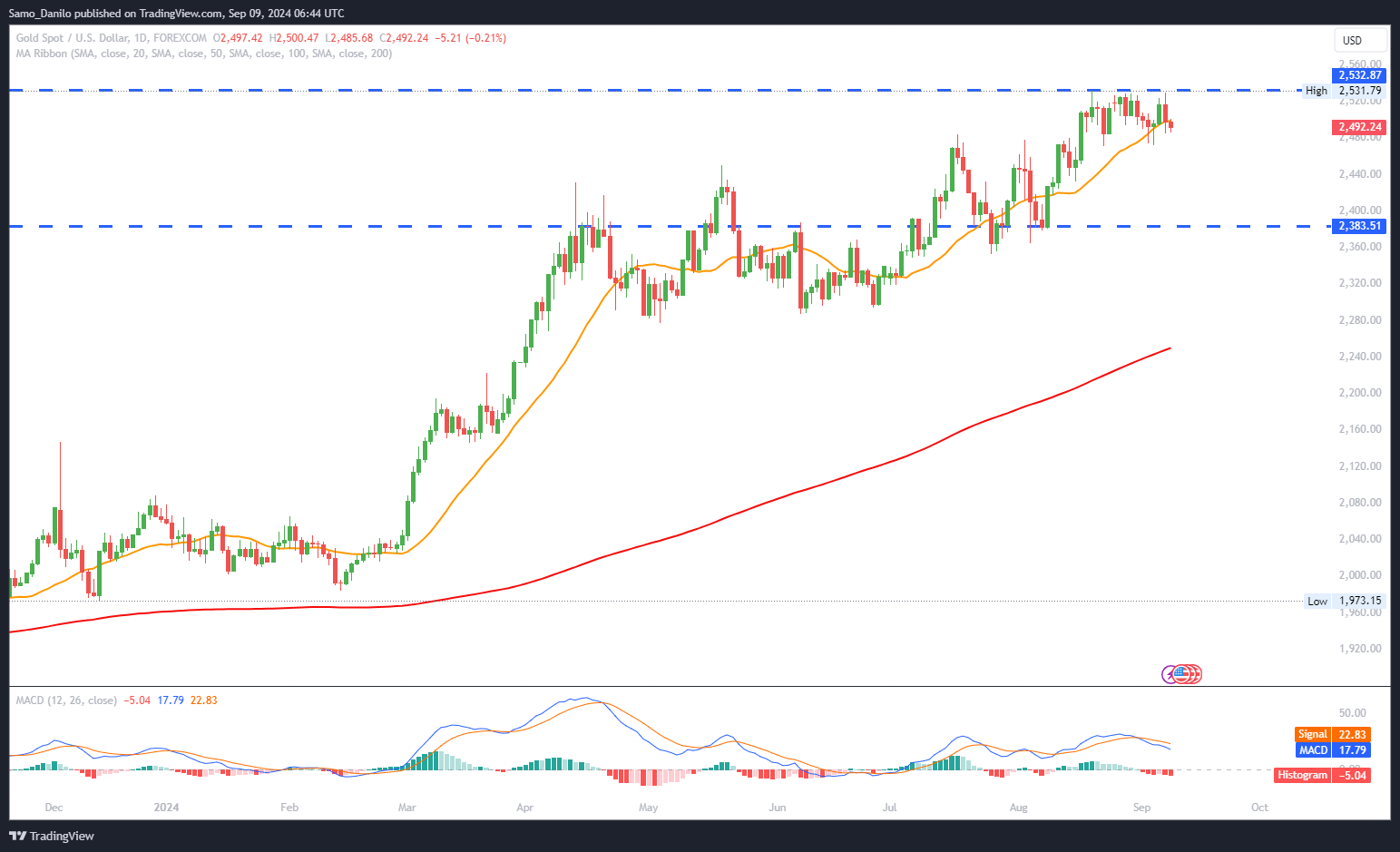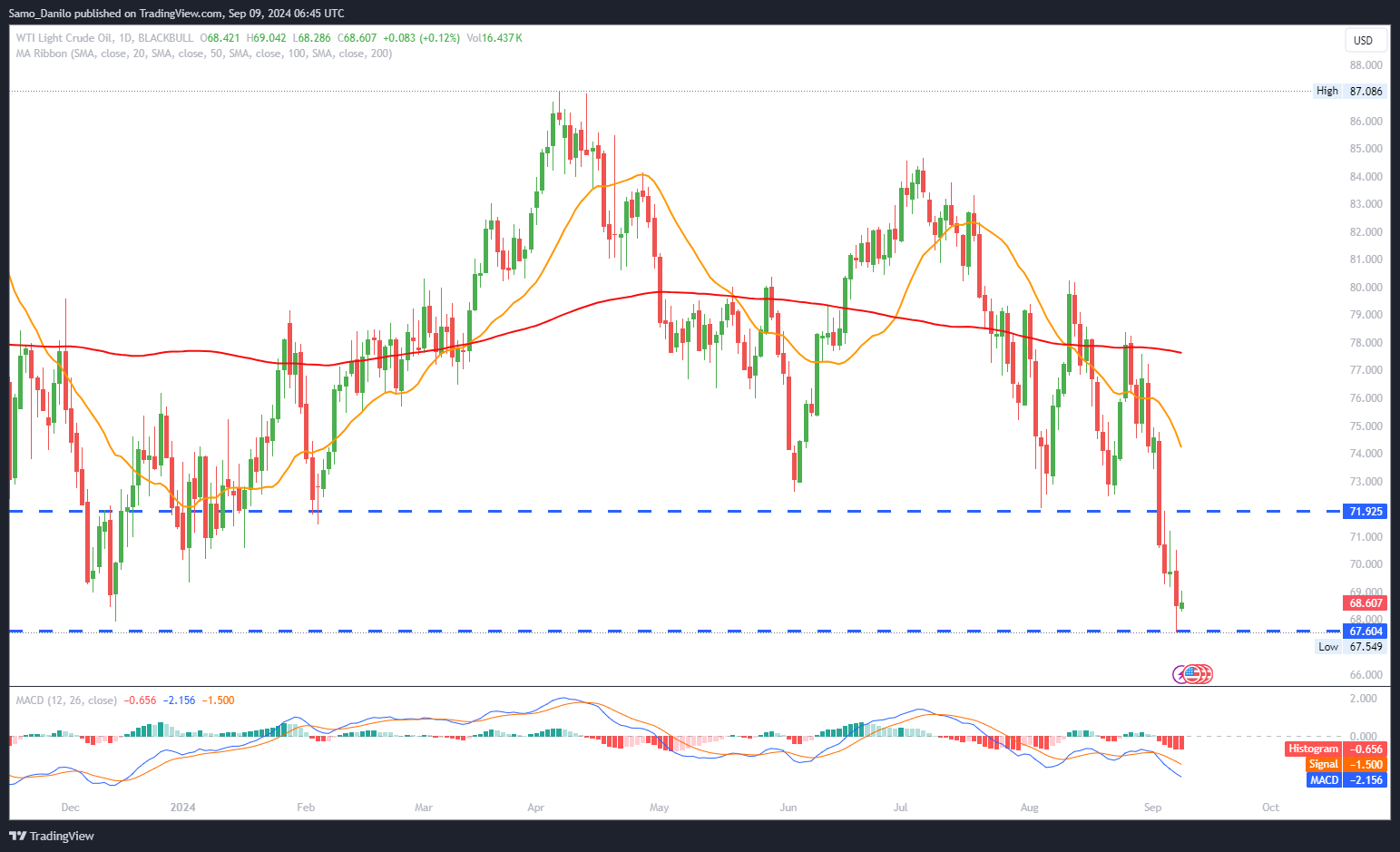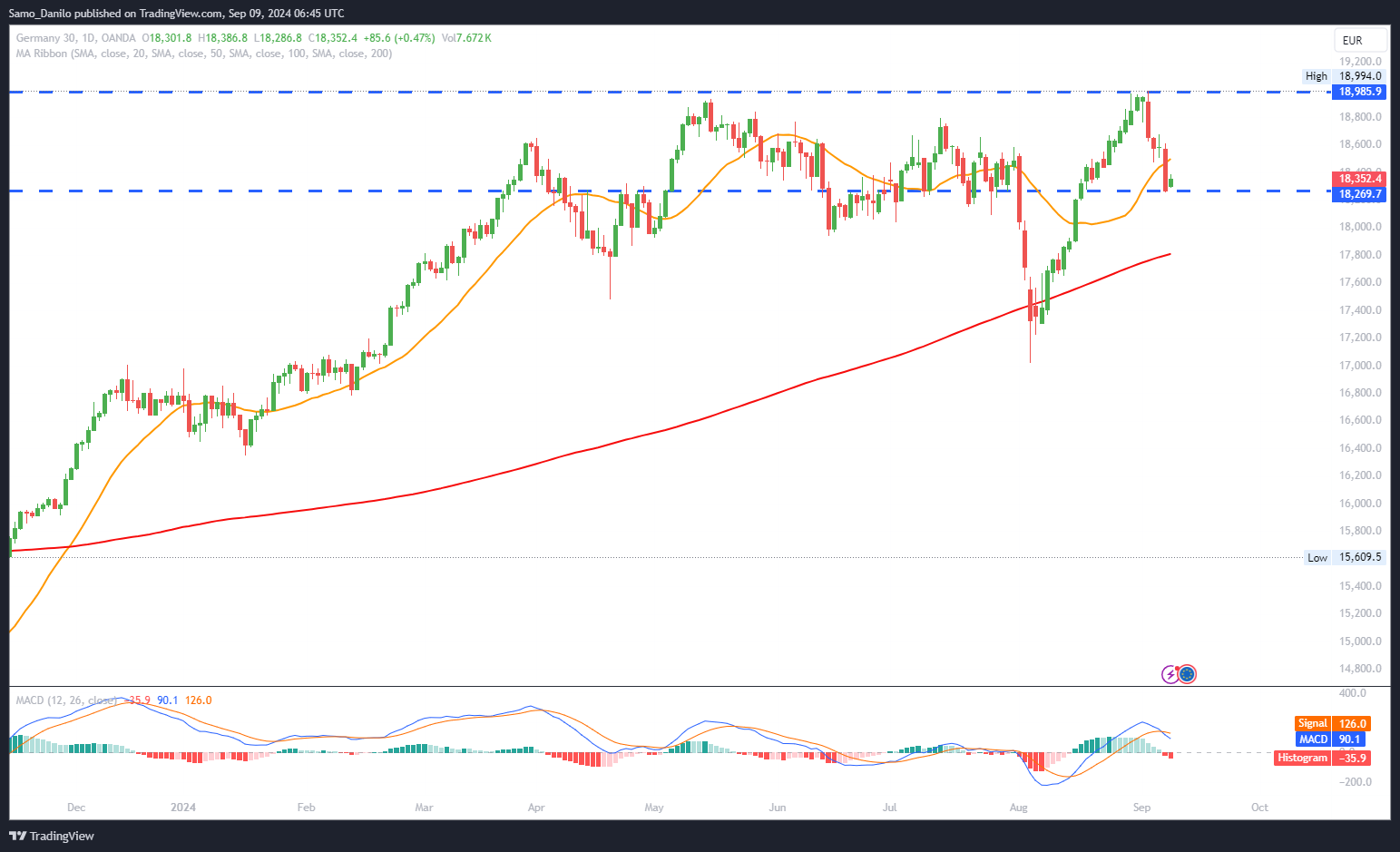EURUSD
- EUR/USD: The pair is attempting to recover some of the previous session’s losses, currently trading near 1.1090 during the European session on Monday. Despite recent weakness, the euro is showing resilience, supported by growing expectations of further monetary easing by the European Central Bank (ECB).
- ECB Monetary Easing Expectations: With headline inflation in the Eurozone approaching 2% and long-term inflation forecasts remaining steady around the same level, the ECB is now seen having sufficient justification to consider easing its monetary policy further. The central bank could potentially cut interest rates or introduce other measures to stimulate the economy as inflation remains subdued.
- Eurozone GDP Impact: Last week’s Eurozone GDP data presented a mixed picture, reinforcing market expectations that the ECB may need to cut rates soon. Slowing growth in the Eurozone has heightened concerns about the region’s economic outlook, adding to the case for more stimulus from the ECB to support the economy.
- US Nonfarm Payrolls (NFP): The US Bureau of Labor Statistics (BLS) reported that the Nonfarm Payrolls for August added 142,000 jobs, below the market forecast of 160,000. However, this was an improvement over the downwardly revised figure of 89,000 for July, providing a somewhat positive signal regarding the US labour market.
- US Unemployment Rate: The Unemployment Rate in the US fell as expected, ticking down to 4.2% from 4.3% in July. This drop in unemployment suggests that the US labour market remains relatively strong, even though job creation is slowing.
Closing statement: EUR/USD is attempting to bounce back from recent losses as expectations for further ECB monetary easing build, supported by stable inflation forecasts and mixed economic data. Meanwhile, the weaker-than-expected US NFP report and a steady decline in the US unemployment rate are keeping the dollar in check. The next steps from the ECB, along with further US labour market data, will be critical for shaping the direction of the pair in the coming sessions.
GBPUSD
- GBP/USD: The pair is facing renewed selling pressure, approaching the 1.3100 level during European trading on Monday. The recent downturn is largely driven by concerns surrounding both the US and UK economies, as investors weigh the latest data and anticipate further developments.
- US Labour Market Concerns: Friday’s US Nonfarm Payrolls (NFP) report showed that the US labor market is losing momentum faster than anticipated, adding to worries about the overall health of the US economy. The slowdown in job growth could lead the Federal Reserve to reconsider its interest rate policy soon.
- Fed Rate Policy Outlook: Austan Goolsbee, President of the Federal Reserve Bank of Chicago, suggested on Friday that the Federal Reserve may soon adjust its policy rate, aligning with market sentiment that a rate cut is becoming more likely. This commentary follows the mixed US labor data and has added pressure on the US Dollar, keeping investors cautious.
- UK Labor Market Weakness: A survey of recruiters revealed that Britain’s labor market cooled noticeably in the last month, with job placements dropping significantly and wage growth decelerating. This slowdown in the labor market is raising concerns about the resilience of the UK economy amid ongoing global economic challenges.
- Upcoming UK Jobs Data: Investors are now shifting their focus to the UK monthly jobs data, which is set to be released on Tuesday. This report will provide further insight into the health of the UK labor market and could influence the Bank of England’s (BoE) future policy decisions.
| SMA (20) | Rising |
|
|
| RSI (14) | Slightly Falling |
| |
| MACD (12, 26, 9) | Slightly Rising |
|
Closing statement: The GBP/USD pair is struggling to find upward momentum as both the UK and US economies show signs of slowing. The potential for a Fed rate cut is keeping pressure on the US Dollar, while concerns over the UK labor market are weighing on the British Pound. The release of the UK jobs report on Tuesday will be key in determining the next direction for the pair, especially as investors remain cautious about the broader economic outlook on both sides of the Atlantic.
GOLD
- Gold Price: Gold is trading just below the $2,500 mark early Monday, maintaining the momentum from Friday’s late rebound. Investors are positioning themselves cautiously ahead of key upcoming data and potential policy shifts, keeping gold in a consolidation phase.
- China’s Inflation Concerns: China's softer-than-expected inflation data is raising concerns about weakening demand in the world's top consumer of commodities, including gold. However, this also spurs speculation that Chinese authorities might introduce stimulus measures to boost the economy, which could indirectly support gold prices by increasing demand for safe-haven assets.
- US Dollar Recovery: On Friday, the US Dollar (USD) staged a late recovery after hitting an eight-day low, in response to the weaker-than-expected US labor market report. The rebound in the USD applied some pressure on gold, though its gains were limited due to the broader economic concerns raised by the employment data.
- Risk-Off Sentiment: The risk-off sentiment in financial markets drove demand for US government bonds, leading to a decline in US Treasury yields. Lower yields tend to support non-yielding assets like gold, which helped limit the downside for gold prices late last week.
- Upcoming US Inflation Data: Investors are keeping an eye on the US inflation data set to be released on Wednesday, which could trigger heightened volatility in both the USD and gold. This data is expected to provide key insights into the Federal Reserve’s rate path, influencing the direction of gold prices in the short term.
| SMA (20) | Rising |
|
|
| RSI (14) | Slightly Falling |
| |
| MACD (12, 26, 9) | Slightly Rising |
|
Closing statement: Gold continues to consolidate below $2,500, supported by global economic concerns and the potential for more stimulus in China. The US Dollar's recovery and US Treasury yields are crucial factors, but the upcoming US inflation data on Wednesday will be pivotal for determining the next significant move in gold prices. Until then, gold is likely to remain
CRUDE OIL
- WTI Price Recovery: West Texas Intermediate (WTI) oil prices are attempting to recover from recent losses, trading around $68.30 per barrel during Monday's European session. After experiencing significant volatility last week, the market is showing signs of stabilizing as traders assess the impact of potential weather disruptions and economic data.
- Hurricane Threat: The US National Hurricane Center (NHC) reported that adverse weather in the southwestern Gulf of Mexico is likely to intensify into a hurricane before reaching the northwestern US Gulf Coast. This region is critical to the US oil refining industry, accounting for approximately 60% of the nation's refining capacity, as noted by Reuters. The threat of production and refining disruptions has provided some support to WTI prices.
- Economic Concerns: Analysts from ANZ cited by Reuters pointed out that crude oil recorded its largest weekly drop in 11 months due to growing concerns about the global economic outlook. Weak jobs data from the US, reported on Friday, exacerbated fears about slowing demand for oil in the world's largest consumer of crude.
- US Jobs Data & Oil Demand: The US Bureau of Labor Statistics (BLS) reported that Nonfarm Payrolls (NFP) in August increased by 142,000 jobs, which was below the forecast of 160,000. While this figure represents an improvement from July’s revised figure of 89,000, it still signals concerns about a cooling labor market, which could negatively impact oil demand.
- Rate Cut Expectations: According to the CME Fed Watch Tool, markets are pricing in at least a 25-basis point (bps) rate cut by the Federal Reserve in its upcoming September meeting. Lower interest rates generally help stimulate economic growth, which can boost oil demand by making crude cheaper for holders of non-dollar currencies.
| SMA (20) | Falling |
|
|
| RSI (14) | Falling |
|
|
| MACD (12, 26, 9) | Falling |
|
|
Closing statement: WTI crude oil prices are attempting to rebound from recent losses as weather-related risks to refining capacity offer temporary support. However, concerns about weak economic data and flagging demand continue to weigh on the market. The anticipation of a potential Fed rate cut in September is expected to provide some relief, as lower rates could stimulate oil demand. For now, traders will keep a close watch on the development of the hurricane threat and further economic data to gauge the next directional move for WTI prices.
DAX
- DAX Decline: The DAX fell to its lowest level since mid-August on Friday, weighed down by weakness in the US technology sector. The decline reflects broader concerns across global markets, with European stocks suffering as well.
- European Stock Weakness: European equities experienced their fifth consecutive session of losses on Friday, marking their worst day since early August. Ongoing worries about an economic slowdown and weaker-than-expected data from the US contributed to the negative sentiment.
- ECB Rate Decision: Investors are closely watching the upcoming meeting of the European Central Bank's (ECB) Governing Council on Thursday. Markets widely expect the ECB to reduce interest rates for the second time this year, in an effort to stimulate the sluggish Eurozone economy. This decision could have a notable impact on DAX-listed stocks, especially as companies brace for further economic uncertainty.
- US Economic Data: The US Nonfarm Payrolls (NFP) report for August added to market concerns, showing that employment increased by 142,000 jobs, well below the forecast of 160,000. This weaker-than-expected data signals an economic slowdown in the US, heightening concerns about global demand, which weighed on European markets, including the DAX.
- Key Data This Week: This week's trading is likely to be influenced by important US economic reports. Key releases include consumer and producer price inflation data for August, as well as the University of Michigan's consumer sentiment survey. These reports are expected to provide further insight into the state of the US economy, which will play a significant role in determining the direction of global equities, including the DAX.
| SMA (20) | Slightly Rising |
|
| RSI (14) | Slightly Falling |
|
| MACD (12, 26, 9) | Slightly Falling |
|
Closing statement: The DAX is facing downward pressure from concerns over global economic growth, particularly in light of weaker-than-expected US data and the struggling tech sector. The ECB's rate decision on Thursday could provide some support if it meets market expectations for a rate cut, but caution remains as traders anticipate key US inflation data later in the week. How these reports shape the outlook for interest rates and economic growth will be critical for the DAX's next move.
